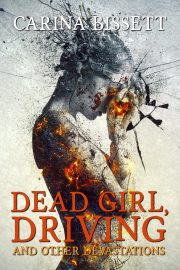Guest Post: Kindle Starter Kit: A Mini-Handbook on Independent Publication
by Nancy Fulda
 When I made my first halting steps into kindle publishing, I was fortunate enough to stumble headlong into Maria Schneider, author of Catch an Honest Thief. She’s been treading the independent waters for years, and taught me pretty much everything I know about indie publishing. Thank you, Maria!
When I made my first halting steps into kindle publishing, I was fortunate enough to stumble headlong into Maria Schneider, author of Catch an Honest Thief. She’s been treading the independent waters for years, and taught me pretty much everything I know about indie publishing. Thank you, Maria!
Today, I’ll focus on kindle publishing, but the principles apply equally well to Nook, Smashwords, PubIt, and other distribution systems.
LESSON #1: Content Comes First
This ought to be a no-brainer, but I’m going to spell it out anyway. Don’t assume that just because kindle publishing has no gatekeepers, you can skip important steps like revision, peer critiques, proofreading, and so forth. Take your time and write a manuscript that’s every bit as worthy of New York publishing as the ones you were actually sending out to agents.
When the manuscript’s finished, watch out for formatting errors in ebook versions. It’s not uncommon for blank lines, wonky characters, or unusual spacing to slip in during the conversion process. For heaven’s sake, look at the book once or twice on an actual e-reader. Don’t just assume your conversion software did a good job.
LESSON #2: Covers Matter
Your book’s cover is probably your single biggest selling point. It’s visual, it’s immediate, and often it will be the biggest reason why potential readers visit (or fail to visit) your Amazon page.
You need an effective, marketable cover, something pretty that you can flash around on the internet. That doesn’t mean that you should shell out money to a cover designer if you can’t afford it. Here are a couple of effective principles for do-it-yourself covers.
Legibility. Customers should be able to read the book’s title. Yes, even in thumbnail versions of the image. Watch out for small or unusually elaborate fonts. Don’t place text in the middle of a high-contrast picture; it will become difficult to read. Instead add a solid-color band behind the text or move it to a more homogeneous region of the image.
Product Placement. Customers will use your cover art to determine (a) what the book is about and (b) the book’s overall tone. If your cover doesn’t accurately reflect the book, you’ll lose most of your potential customers. The people who would have loved the book will never see it because they didn’t bother to click the cover image. The people who clicked on the cover image won’t buy it because it’s not what they expected to find on the other end of that click.
Keep your cover true to the book. Don’t select a dramatic, gruesome cover image for an upbeat chick-lit novel. No, not even if the scene actually occurs in the book. Similarly, don’t use bright, cheerful colors on the cover of a novel that deals with weighty issues like depression, psychosis, or guilt.
Stock Photography. A lot of authors don’t know it, but there are hundreds of thousands of images on the internet available for commercial use at very reasonable rates. Stock photography is your friend. Spend a few minutes poking around Shutterstock, istockphoto, or Dreamstime to see what’s available in your price range. There are also public domain image repositories, although the quality of the artwork is generally inferior.
LESSON #3: Reviews Are Also Important
Ever visited a product on Amazon that had no customer reviews? It screams “newbie”, doesn’t it? It screams “bad product”. It says things you don’t want any Amazon page saying about your work.
Yes, customers pay attention to reviews. Yes, a good rating will help sell your book. And yes, reviews are notoriously hard to get.
Sure, you can ask your mother to post a review. But if she’s never reviewed anything else on Amazon her review isn’t likely to get much attention from serious online customers. They’re savvy. They know how easy it is to plant a review, and they know how to check on a reviewer’s history. In fact, a stream of five star, “This is the awesomest book EVER!!!” reviews might even turn customers off.
While we all hunger for positive reviews, what we need most are HONEST reviews. Reviews written by real reviewers, people who will provide customers with useful information about the book.
How do you get them? Send your work to review sites, of course. There are listings of review venues that accept indie publications here and here. Be sure to read each site’s guidelines and resist the tempation to media blast every email address you find.
Not only will review sites drive traffic to your book, but many of them will post their reviews to Amazon, Barnes & Noble, and GoodReads. And they review a LOT of books, which makes their reviews more credible.
The downside to this process? Most reviewers are dreadfully backlogged. Expect 3-6 months to pass before reviews start coming in. Some reviewers are booked out more than a year in advance. For this reason, some indie authors have begun sending ARCs to reviewers well in advance of the book’s release date.
If you need to get reviews up faster, try offering free copies of the book in exchange for an honest, thoughtful review at an online retailer. Also, once you’ve set up your Amazon Author Central page, you’ll be authorized to place editorial reviews in the book’s information page.
One more note: I spent two weeks trying to figure out how to send out free kindle review copies. It turns out, there’s no way to do this via Amazon. You can gift a kindle book to a friend, but you have to pay for it with your own money. Kind of silly, huh?
Fortunately, there are other ways to get review copies. I’ve heard good things about the Calibre software package. Also, if you upload your book to Smashwords you’ll have access to file formats compatible with kindle, nook, and onscreen PC reading. Smashwords also lets you create discount coupons that you can give to friends and reviewers.
LESSON #4: The Blurb is Important, Too
Seriously. You’ve got like, twenty seconds to hook a customer’s attention or it’s —click — off to the next product. The marketing description displayed next to your book cover at Amazon and other online retailers may be short, but it’s critically important.
Ask other writers to critique your blurb the same way you’d ask them to critique the story. Let them tell you what catches their interest and what doesn’t. Listen to what they say. Consider adding a catchy tagline at the top of the blurb to attract interest.
LESSON #5: Appropriate Reverence for the Almighty Algorithm
This is perhaps the single least understood thing about independent publishing. Amazon has spent — I don’t know how much — probably hundreds of thousands of dollars fine-tuning a product matching system that puts books in front of the eyes of readers who bought similar books. You can see this in action on virtually any Amazon product page. Down beneath the product description is a field labeled “Customers Who Bought This Item Also Bought”.
This “Customers Who Bought” algorithm is priceless. If you have a good cover, a good blurb, good reviews and enough sales to give Amazon statistically reliable data, the algorithm will put your book in front of the eyes of thousands of readers who are already predisposed to like it.
I have heard successful kindle authors say things like: “I didn’t do it. The algorithms picked me up, and the book just took off.”
Is this going to happen for everyone? Heck, no. But those product matching algorithms are a distribution channel worth fighting for. I know authors who are selling in excess of 500 books a month on kindle purely on the strength of those algorithms.
According to Maria (and this corroborates with my experience selling Dead Men Don’t Cry), Amazon’s “People who Viewed…” feature starts appearing at around 10 sales, and the “People who Bought…” feature starts appearing at around twenty sales. Also, Amazon can’t match your book up effectively unless it knows what kind of book it is. In Kindle Direct, be sure to set up accurate categories and tags for your book. Also add tags as a customer, and encourage your fans to do so, as well.
From what I’ve heard, sales tend to start small and build slowly. It’s not uncommon to spend 3-6 months inching along at five sales per month before the algorithm data reaches critical mass. Also, if you don’t promote, sales won’t build at all. You have to prime the pump.
LESSON #6: Pricing is Powerful
What price do you think is appropriate for a 211-page ebook? $7.99? $4.95?
Got an answer? All right, do me a favor: click through this link and look at the pricing. (UK readers, use this one.) I’ll wait.
Took a lot of you by surprise, didn’t it? In fact, at that price, you were almost tempted to buy it. There’s a rabid impulse buyer in the back of your brain whispering “Why not?”
That purchasing urge gets stronger the lower the price goes. Get down into the $0.99 range, and you are in Happy Impulse Purchase Land. People won’t think twice about buying; if the book looks remotely interesting, they’re likely to just toss it in the shopping cart.
Here’s something I didn’t know a month ago: The kindle market is not primarily populated by early adopters and techno-geeks. The Cheap Book Crowd — the customers who never even made it onto most publishers’ radar because they go to libraries and shop in used book stores — has fallen in love with kindle. Buyers have been known to spend up to $200 per month on $0.99 books.
Price matters.
I’m not sure what the optimal price for any given book is. Romance — especially YA romance — seems to do extremely well in the $0.99 range. More academic books may need a higher price to maintain their image and credibility. Also, that 70% Amazon royalty ratio is awfully tempting and it doesn’t kick in until the price reaches at least $2.99. My point isn’t to advocate any particular pricing strategy, but to make it clear that your price WILL affect your sales rate. Sometimes drastically.
For a fascinating example of the power of price, see Victorine Lieske’s guest post on J.A. Konrath’s blog.
A strategy I’ve seen commonly applied — to extremely good effect — is to price the first book in a series at $0.99 and the others somewhat higher. Buyers are more likely to take a chance on an unknown author if the financial risk is minimal. Once you’ve established their trust, they’re sometimes willing to pay more.
LESSON #7: Don’t Mislead the Reader
If your book is a short story, for heaven sakes, label it clearly! No one likes buying a “novel” only to discover it’s 4000 words long. Include a page count / word count in your product description. If your book is an anthology or collection, clearly state how many stories it includes.
LESSON #8: You Guessed It — Promotion
Books do not sell themselves. Amazon will sometimes sell your books for you, but only if you’ve first collected a decent sales history.
Don’t be afraid to promote, and take care to concentrate your promotional efforts online, where the ebook readers are. If you link to your books from your web site, use the format name (Nook, Kindle, etc.) rather than outlet names like Amazon and Barnes & Noble. (My experience is that the general public knows what kind of reader it has, and doesn’t much care which retailer they buy from.)
Also, be sure to include hotlinks at the back of each book. If you have five or six books on the market, and each one links to two or three others, they can become an effective sales-driving force for each other.
Many people recommend being active on the Kindle Boards and other discussion forums as a form of promotion. I haven’t noticed any sales benefit of belonging to these groups, but I think you should do it anyway. The information you glean there is priceless.
•••
Nancy Fulda is a Phobos Award Winner, a Vera Hinckley Mayhew Award recipient, and this year’s Jim Baen Memorial Award winner. Her fiction has appeared in Asimov’s Science Fiction magazine, Jim Baen’s Universe, and Baen.com. This post first appeared on her blog.


